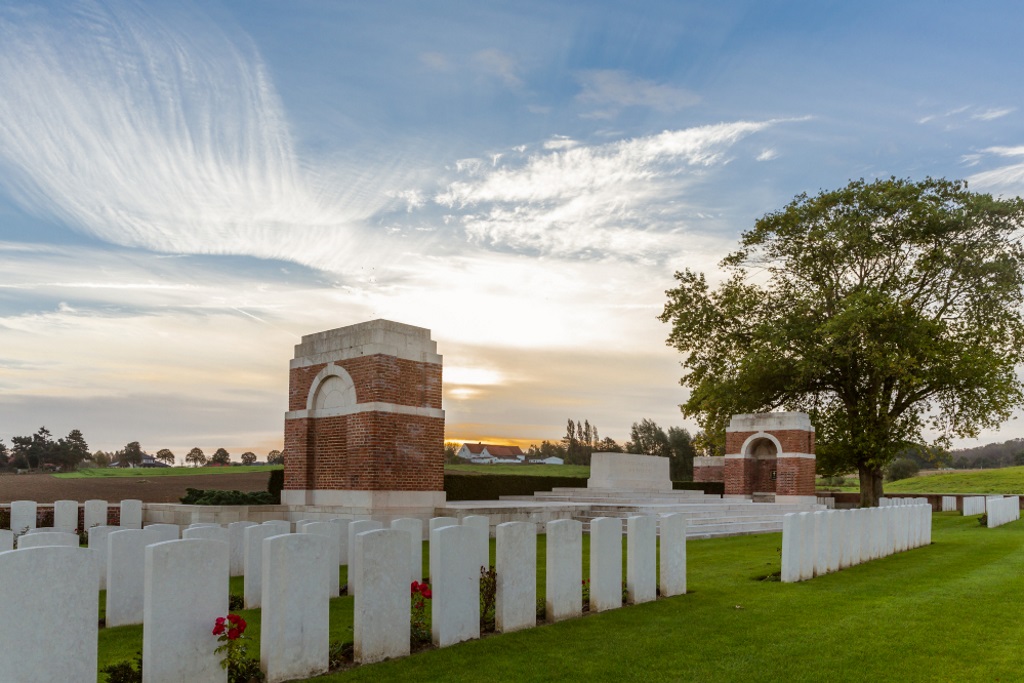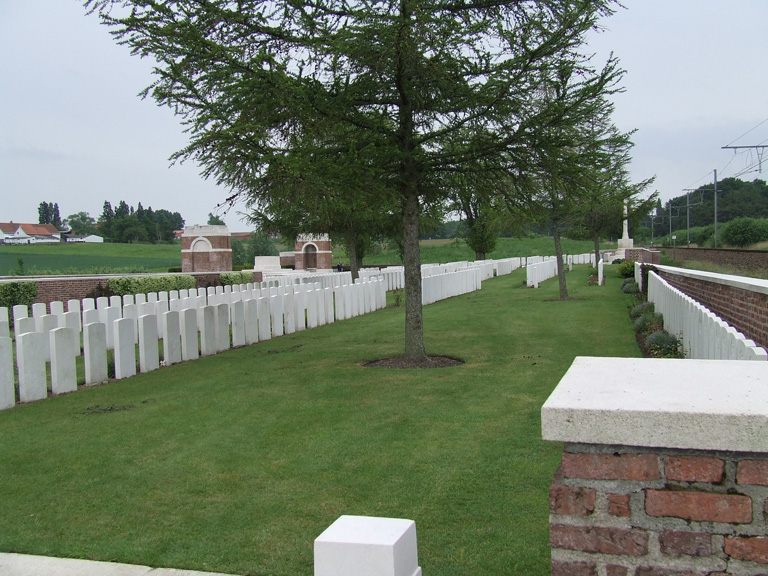Larch Wood (Railway Cutting) Cemetery
- Country Belgium
- Total identified casualties 542 Find these casualties
- Region West-Vlaanderen
- Identified casualties from First World War
- GPS Coordinates Latitude: 50.82814, Longitude: 2.923
Location information
Larch Wood Cemetery is located 4 Kms south-east of Ieper town centre, on the Komenseweg, connecting Ieper to Komen (N366). From Ieper town centre the Komenseweg is located via the Rijselsestraat, through the Rijselpoort (Lille Gate) and crossing the Ieper ring road, towards Armentieres and Lille. The road name then changes to Rijselseweg. 1 Km along the Rijselseweg lies the left hand turning onto Komenseweg. 2.7 Kms along the Komenseweg lies the left hand turning onto Larch Wood Cemetery. The cemetery itself is located 400 metres along a rough single tracked road which leads to an ungated railway crossing, immediately adjacent to the site.
Visiting information
Wheelchair access to cemetery with some difficulty.For further information regarding wheelchair access, please contact our Enquiries Section on telephone number 01628 507200
History information
The cemetery was begun in April 1915 at the North-end of a small plantation of larches. It was used by troops holding this sector, particularly the 46th (North Midland) Division and the 1st Dorsets, until April 1918. It was enlarged after the Armistice when graves were brought in from the battlefields of Ypres and from the following smaller cemeteries:-
AMERICA CROSS ROADS GERMAN CEMETERY, WERVICQ, (named from a cabaret between Wervicq and Kruiseecke) contained the graves of five soldiers from the United Kingdom who fell in October, 1914.
BRUGES GENERAL CEMETERY, ST. MICHEL, contained the graves of 32 soldiers and airmen from the United Kingdom and one Canadian merchant seaman.
CORTEMARCK GERMAN CEMETERY, No.1, a little North-West of the village, contained the grave of two R.F.C. officers.
EERNEGHEM GERMAN CEMETERY, a little East of Eerneghem, that of one R.A.F. officer.
GHISTELLES CHURCHYARD contained the graves of two British soldiers who fell in July, 1917. There was a German aerodrome at Ghistelles, and the Germans used a plot in the Churchyard for war burials.
GROENENBERG GERMAN CEMETERY, ZANTVOORDE (on the South side of "Shrewsbury Forest"), contained the graves of four soldiers from the United Kingdom who fell in February, 1915,
HANDZAEME GERMAN CEMETERY (on the North side of the village) those of two Canadian soldiers who fell in May, 1915, and
ICHTEGHEM GERMAN CEMETERY (a little West of Ichteghem) those of two unknown R.A.F. officers.
LEFFINGHE GERMAN CEMETERY (on the North side of the village) contained the graves of one R.F.C. officer who fell in July, 1917, and three unknown soldiers from the United Kingdom; and
MARCKHOVE GERMAN CEMETERY, CORTEMARCK, those of ten soldiers and airmen from the United Kingdom who fell in 1918.
OUDENBURG CHURCHYARD contained the graves of two soldiers from the United Kingdom who fell in 1917, and TENBRIELEN COMMUNAL CEMETERY GERMAN EXTENSION those of six who fell in 1914.
THOUROUT GERMAN CEMETERY No.2 (on the road to Jabbeke, beyond the railway line), contained the graves of seven soldiers and airmen from the United Kingdom and one from Canada; VLADSLOO GERMAN CEMETERY (near the Church) those of two R.F.C. officers who fell in 1917; and WARNETON SUD-ET-BAS GERMAN CEMETERY those of two unknown British soldiers who fell in 1918.
WERVICQ COMMUNAL CEMETERY and its EXTENSIONS (on the Belgian side of the Lys) contained the graves of 62 soldiers from the United Kingdom and six from Canada.
WIJNENDAELE GERMAN CEMETERY, THOUROUT, contained the graves of two flying officers from the United Kingdom and one from Canada; and ZANTVOORDE GERMAN CEMETERY (called also De Voorstraat No.49) those of eleven soldiers from the United Kingdom who fell in 1914.
The cemetery contains 856 burials and commemorations of the First World War. 321 of the burials are unidentified and there are special memorials to 82 casualties known or believed to be buried in the cemetery. Other special memorials record the names of five casualties buried in German cemeteries whose graves could not be found on concentration.
The cemetery was designed by Sir Edwin Lutyens.




